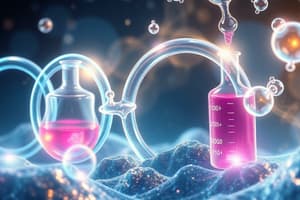Podcast
Questions and Answers
What is the chemical formula for Methane?
What is the chemical formula for Methane?
- C4H10
- C3H8
- CH4 (correct)
- C2H6
What is the chemical formula for Ethane?
What is the chemical formula for Ethane?
- C4H10
- CH4
- C3H8
- C2H6 (correct)
What is the chemical formula for Propane?
What is the chemical formula for Propane?
- C5H12
- C2H6
- C4H10
- C3H8 (correct)
What is the chemical formula for Butane?
What is the chemical formula for Butane?
What is the chemical formula for Pentane?
What is the chemical formula for Pentane?
What is the chemical formula for Hexane?
What is the chemical formula for Hexane?
What is the chemical formula for Heptane?
What is the chemical formula for Heptane?
What is the chemical formula for Octane?
What is the chemical formula for Octane?
What is the chemical formula for Nonane?
What is the chemical formula for Nonane?
What is the chemical formula for Decane?
What is the chemical formula for Decane?
Ionic bonds involve the transfer of electrons.
Ionic bonds involve the transfer of electrons.
Covalent bonds involve the sharing of electrons.
Covalent bonds involve the sharing of electrons.
Electronegativity is used to determine whether a bond will be ____ covalent, polar covalent, or an ionic bond.
Electronegativity is used to determine whether a bond will be ____ covalent, polar covalent, or an ionic bond.
What is the range of electronegativity values?
What is the range of electronegativity values?
How are bonds classified?
How are bonds classified?
What is the Octet Rule?
What is the Octet Rule?
What determines the strength of ionic bonds?
What determines the strength of ionic bonds?
What is the basis of attraction for hydrogen bonds?
What is the basis of attraction for hydrogen bonds?
How many types of solutions are there?
How many types of solutions are there?
The process of dissolution represents a competition between the energy of the ____ interactions, the ____ forces of the solute itself, and the intermolecular forces of the ____ itself.
The process of dissolution represents a competition between the energy of the ____ interactions, the ____ forces of the solute itself, and the intermolecular forces of the ____ itself.
Water can act as both a hydrogen bond acceptor and donor.
Water can act as both a hydrogen bond acceptor and donor.
What are resonance structures?
What are resonance structures?
What defines the strength of London dispersion forces?
What defines the strength of London dispersion forces?
The strength of the solute-solvent interactions is greater than the sum of the solute-solute and solvent-solvent interactions when it is favorable for solution formation.
The strength of the solute-solvent interactions is greater than the sum of the solute-solute and solvent-solvent interactions when it is favorable for solution formation.
Flashcards are hidden until you start studying
Study Notes
Alkanes
- Methane (CH4): Contains 1 carbon atom.
- Ethane (C2H6): Comprises 2 carbon atoms.
- Propane (C3H8): Has 3 carbon atoms.
- Butane (C4H10): Includes 4 carbon atoms.
- Pentane (C5H12): Consists of 5 carbon atoms.
- Hexane (C6H14): Contains 6 carbon atoms.
- Heptane (C7H16): Comprises 7 carbon atoms.
- Octane (C8H18): Has 8 carbon atoms.
- Nonane (C9H20): Includes 9 carbon atoms.
- Decane (C10H22): Comprises 10 carbon atoms.
Chemical Bonds
- Ionic Bond: Involves complete transfer of electrons to achieve noble gas configuration.
- Covalent Bond: Electrons are shared between atoms for full valence shells.
- Nonpolar Covalent Bonds: Electrons shared equally between bonded atoms.
- Polar Covalent Bonds: Electrons shared unequally, creating dipoles.
Electronegativity
- Defined as an atom's ability to attract shared electrons; crucial in determining bond types.
- Electronegativity values range from 0.7 to 4.0; larger values indicate stronger attraction.
- Increases from left to right and bottom to top on the periodic table.
Bond Classification
- Pure Covalent Bonds: Electronegativity difference of 0-0.4; electrons shared equally.
- Polar Covalent Bonds: Difference >0.4-2.0; electrons shared unequally (e.g., H-F).
- Ionic Bonds: Difference >2.0; total electron transfer (e.g., NaCl).
Lewis Structures
- Lewis structures represent electron arrangement and bonding in a molecule.
- Key steps include calculating total valence electrons, drawing skeletal structures, and adjusting for octets.
- "Lone Pairs" refer to nonbonding electrons in the valence shell.
Molecular Geometry and VSEPR Theory
- VSEPR (Valence Shell Electron Pair Repulsion) model states that electron groups strive to maximize distances to minimize repulsion.
- Smple lines, wedges, and dashed lines represent 3D bonding orientations.
Hybridization and Orbitals
- Hybrid orbitals (e.g., sp, sp2, sp3) result from combining atomic orbitals to accommodate bonding.
- Sigma bonds are formed by end-to-end overlap of orbitals, while pi bonds occur with parallel p orbital overlaps.
Intermolecular Forces
- Intramolecular forces are strong bonds within molecules, while intermolecular forces exist between different molecules.
- Types include dipole-dipole interactions, hydrogen bonds, and London dispersion forces.
- Hydrogen bonds are particularly strong and involve H bonded to highly electronegative atoms (O, N, F).
Solutions and Solubility
- Solutions can exist in various phases (gas, liquid, solid) with defined solute-solvent interactions.
- Competitive energy interactions determine whether a solute dissolves.
- Solute-solvent interactions must be stronger than solute-solute and solvent-solvent interactions for solubility.
Resonance Structures
- Resonance describes multiple valid Lewis structures for a molecule differing only in electron placement.
- The actual molecular structure is a resonance hybrid of possible forms, which adheres to rules (e.g. maintaining octets).
- Assess resonance forms based on factors like bond number, charge distribution, and adherence to octet rule.
Magnetic Properties
- Paramagnetic substances have unpaired electrons and are attracted to magnetic fields, while diamagnetic substances have paired electrons and are weakly repelled.
Bond Energies
- Different intermolecular forces and bonding types vary in strength and energy involved, influencing physical properties of substances.
Studying That Suits You
Use AI to generate personalized quizzes and flashcards to suit your learning preferences.




